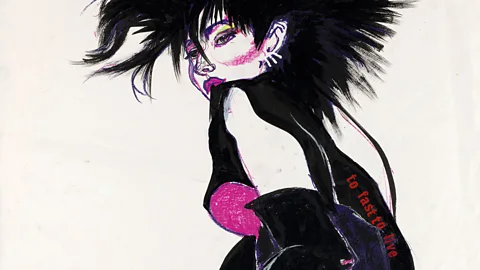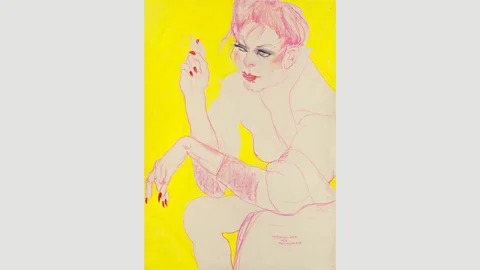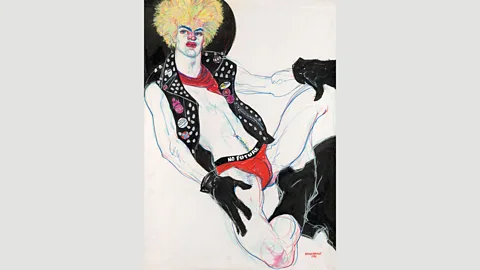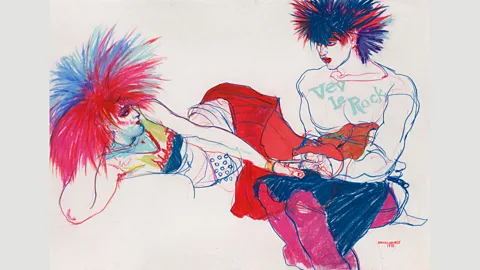Exploring the beauty of London’s punks and fetish clubs
 Estate of Jo Brocklehurst
Estate of Jo BrocklehurstDisguised in a wig and sunglasses, the artist Jo Brocklehurst went undercover to draw some of the larger-than-life figures of London’s nightlife at fetish clubs and punk gigs. But her extraordinary body of work – including portraits of everyone from Boy George to Billy Idol – has remained largely unknown.
An exhibition of her work created from the 1960s up to her death in 2006, called Nobodies and Somebodies, may change that. The show reveals an unparalleled window into the subversive underbelly of punk, as well as the first connective sparks between this local subculture and the international fashion world.
“She was a true artist, the real deal, drawing every day of her life,” says Isabelle Bricknall, Brocklehurst’s close friend and co-curator of the exhibition. “The objective was never money. The art establishment at that time wouldn’t have touched punks with a ten-foot bargepole, but she saw something there. She was ahead of her time.”
 Estate of Jo Brocklehurst
Estate of Jo BrocklehurstA child prodigy, Brocklehurst was offered a scholarship to study at renowned Saint Martin’s School of Art at the tender age of 14. She graduated four years later, by which time the staid traditions of fashion illustration, mainly tasteful renditions of Parisian haute couture, were no longer exciting. Brocklehurst took her rigorous academic training and turned her attention to London’s seedy underworld, immersing herself in the nascevnt punk scene of the late 1960s and the fetish clubs where people were exploring alternative sexualities.
Brocklehurst frequented these overlooked corners of the city in disguise and with her sketchbook in hand, moving around stealthily to capture her subjects at their most unguarded moments.
Her personal life was equally secretive. Brocklehurst always refused to reveal her exact age, but it has been accepted she was born at some point in the 1930s, the illegitimate child of an affair between a senior political figure from Sri Lanka and an English mother. She was so guarded about her background that many of her friends did not even realise her dual heritage.
 Estate of Jo Brocklehurst
Estate of Jo BrocklehurstBright lights, big cities
She also had an uncanny ability to be in the right place at the right time. A tireless traveller, Brocklehurst spent extended periods in Berlin and New York, crossing paths with everyone from Siouxsie Sioux and Billy Idol to Andy Warhol and Keith Haring. She even exhibited in the headline-grabbing 1980 exhibition at London’s Institute of Contemporary Arts, Women’s Images of Men, followed by successful gallery shows in the city in 1981 and 1982. Whether immersed in the anti-establishment spirit of the 1960s, hanging around with the 1970s Pop artists in New York, a stalwart of the Blitz club kids scene in 1980s Soho, she was always observing, always recording – and always honing her craft.
“Despite all that, she was never seduced by fame,” Bricknall says. “Everyone knew who she was, and would try and jump in front of her and get their picture drawn in the clubs. Even with the following generations, people like Alexander McQueen and John Galliano, who were around when Jo was a septuagenarian. She became one of fashion’s best-kept secrets. If you were really hip and happening, Jo would draw you. The irony is that she never knew who the people were; she had no interest in celebrity. It was usually up to me to identify who she’d drawn on one of her nights out.”
 Estate of Jo Brocklehurst
Estate of Jo BrocklehurstBrocklehurst’s style is often linked to that of Egon Schiele: wiry, fluid lines used to describe the topography of the human form, contorted poses and theatrical gestures and luminous eyes that arrest the viewer with a cold and magisterial gaze. But she arguably fits better into the lineage of 20th-Century documentary artists who placed their subjects first and their egos second. Like Diane Arbus or Mary Ellen Mark, Brocklehurst shows an interest in those who lived their lives at the fringes of society, granting them the dignity they may never have been afforded elsewhere.
Sunglasses at night
“She loved Leonora Carrington and Frida Kahlo, for example, because they were women of convinction. They stepped outside the norms of their societies,” says Bricknall. “She was aware of the importance of her gender in being a documentary artist, because there’s a certain trust afforded to women that means they can go places men can’t. Even though she could be quite an intimidating presence – fabulous looking and a lady of mystery – people were drawn to her like a magnet.”
As records of the culture in which they were produced, the drawings offer a refreshingly personal antidote to the black-and-white photography of punk’s genesis you might find elsewhere. Brocklehurst saw her subjects in pulsing, kaleidoscopic colour: the heat flushing their cheeks, thick veins winding up their forearms, lurid pink flesh that seems to throb. It’s a visceral experience witnessing them up close, dragging the viewer into the din and heat of their underground world. By isolating her subjects from the chaotic context of a club or a drag bar, she grants them a seductive subjectivity. We're left to fill in the gaps, to construct our own debauched narratives for each of these weird and wonderful characters.
“She saw her art as a sacred act – and if I say that to some people, their shutters come down, because it's not cool to think about it like that – but Jo was very spiritual. She was drawing with sunglasses on, and I’d see her pick up her pencils or brushes and start making these initial marks in vibrant colours. I asked her how she did that, and she explained that she saw auras around people. On the fetish scene, she saw people as either angelic or demonic, and she'd represent that.”
Brocklehurst might come across like a classic British eccentric, but her prodigious abilities and relentless curiosity speak otherwise. Her work isn’t just impressive for its refusal to patronise its subjects, but also for its playfulness and wit.
 Estate of Jo Brocklehurst
Estate of Jo BrocklehurstA final series is displayed at the end of the exhibition, inspired by Alice in Wonderland – supposedly from after Brocklehurst returned from a stint in New York and felt compelled to reacquaint herself with a sense of Englishness. Cream teas and summer fetes, however, this is not. Brocklehurst offers a radical reimagining of the characters, the Queen of Hearts resplendent in an armour-like fetish gown. At a time when the transgressive edges of London's nightlife are gradually eroding, let's hope Brocklehurst’s drawings, and the thrilling culture that went with it, don’t end up as relics of a bygone Britain.
This story is a part of BBC Britain – a series focused on exploring this extraordinary island, one story at a time. Readers outside of the UK can see every BBC Britain story by heading to the Britain homepage; you also can see our latest stories by following us on Facebook and Twitter.
If you would like to comment on this story or anything else you have seen on BBC Culture, head over to our Facebook page or message us on Twitter.
And if you liked this story, sign up for the weekly bbc.com features newsletter, called “If You Only Read 6 Things This Week”. A handpicked selection of stories from BBC Future, Earth, Culture, Capital, Travel and Autos, delivered to your inbox every Friday.
